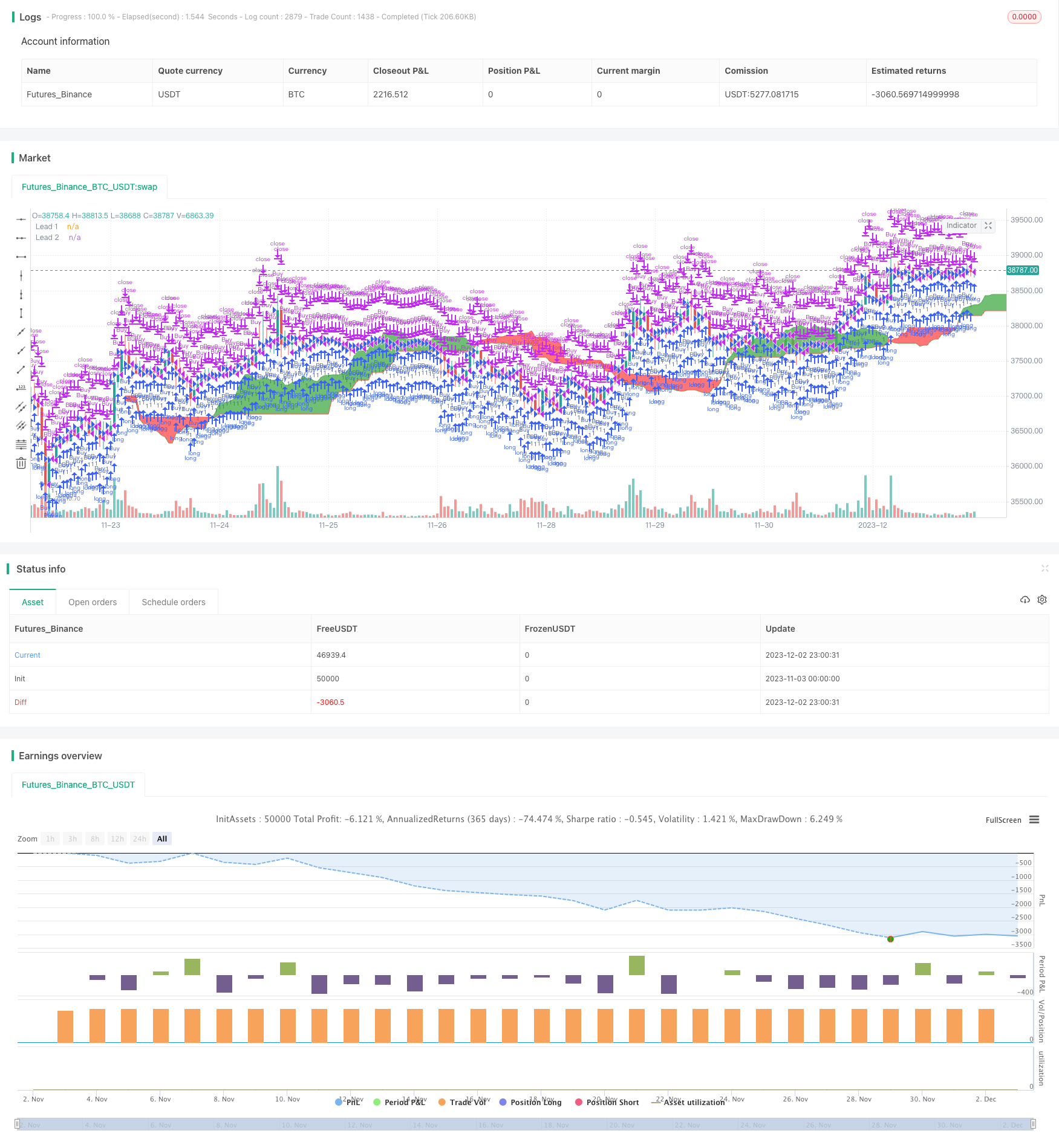
概述
大悦多因子量化策略是一种同时结合均线、MACD、Ichimoku云图多种技术指标的长线追涨策略。它主要利用200日简单移动均线判断总体行情方向,再结合20日指数移动均线、MACD指标和Ichimoku云图提供更多细节信号,从而决定具体的止盈止损点。
该策略同时考量长短期趋势以及多因子验证,可以有效过滤假突破带来的噪音交易。它追求优质机会的同时控制风险,适合有经验的投资者用于中长线持仓。
策略原理
当价格处于200日移动均线之上时,策略认为是牛市,此时只要20日均线和MACD指标同时发出买入信号,并且价格高于云图的最高价格或位于云图当中,则产生买入信号。
当价格跌破200日移动均线时,策略认为步入熊市,此时要求信号更为严格:必须20日均线和MACD指标同时发出买入信号,并且Ichimoku云图必须同向发出买入信号(绿云或者价格高于云图最高价格),才会产生买入信号。
卖出信号的判断逻辑与买入信号类似,但是方向相反:在牛市中价格只要跌破云图底部或云图反转;在熊市中只要价格进入红色云图或20日均线和MACD指标发出卖出信号则产生卖出。
优势分析
这套策略最大的优势在于同时结合长短期多种指标判断市场结构,可以有效滤除假信号。具体来说,主要有以下几点:
- 200日移动均线判断总体行情趋势,避免逆势操作。
- 20日均线关注近期动态,捕捉转折机会。
- MACD指标验证趋势是否改变。
- Ichimoku云图再次验证,防止产生错误信号。
通过多层指标验证,可以大大提高盈利概率。此外长短期指标的配合也使策略同时适合短线和中长线操作。
风险分析
该策略主要风险在于多个指标同时发出错误信号的概率。尽管山穷水尽疑无路的时候,这种概率极低,但长期操作中依然难免发生。主要应对方法是:
适当调整参数,例如采用均线期数,寻找最佳参数组合。
严格止损,错误信号后及时止损切换方向。策略本身没有设置止损,可以在实盘中补充。
采用期货套期保值等方法锁定利润。
根据大周期级别的支持位适当调整仓位。
优化方向
该策略可以从以下几个方面进行优化:
测试不同参数的效果:可以尝试改变均线周期、云图参数等,找到最佳参数组合。
增加止损模块:适当的移动止损可以更好控制风险。
结合相关性指标:例如涨跌速率,可以避免追高杀跌。
引入机器学习:使用神经网络等方法训练指标权重。
多市场验证:在不同市场中验证策略健壮性。
总结
大悦多因子量化策略通过科学的指标组合过滤噪音信号,在控制风险的前提下持续盈利。它既考量大周期趋势又关注短期机会,可广泛使用在中长线投资中。通过参数优化、止损优化以及机器学习引入等方法,该策略有望产生更加优异的效果。
/*backtest
start: 2023-11-03 00:00:00
end: 2023-12-03 00:00:00
period: 1h
basePeriod: 15m
exchanges: [{"eid":"Futures_Binance","currency":"BTC_USDT"}]
*/
//@version=2
strategy(title="MACD/EMA/SMA/Ichimoku Long Strategy",overlay=true)
// Ichimoku
conversionPeriods = input(9, minval=1, title="Conversion Line Periods"),
basePeriods = input(26, minval=1, title="Base Line Periods")
laggingSpan2Periods = input(52, minval=1, title="Lagging Span 2 Periods"),
displacement = input(26, minval=1, title="Displacement")
donchian(len) => avg(lowest(len), highest(len))
conversionLine = donchian(conversionPeriods)
baseLine = donchian(basePeriods)
leadLine1 = avg(conversionLine, baseLine)
leadLine2 = donchian(laggingSpan2Periods)
p1 = plot(leadLine1, offset = displacement, color=green,
title="Lead 1")
p2 = plot(leadLine2, offset = displacement, color=red,
title="Lead 2")
fill(p1, p2, color = leadLine1 > leadLine2 ? color(green,50) : color(red,50))
bottomcloud=leadLine2[displacement-1]
uppercloud=leadLine1[displacement-1]
// SMA Indicator - Are we in a Bull or Bear market according to 200 SMA?
SMA200 = sma(close, input(200))
EMA = ema(close,input(20))
//MACD Indicator - Is the MACD bullish or bearish?
fastLength = input(12)
slowlength = input(26)
MACDLength = input(9)
MACD = ema(close, fastLength) - ema(close, slowlength)
aMACD = ema(MACD, MACDLength)
delta = MACD - aMACD
// Set Buy/Sell conditions
[main,signal,histo]=macd(close,fastLength,slowlength,MACDLength)
buy_entry = if ((uppercloud>bottomcloud or close>max(uppercloud,bottomcloud)) and close>EMA and (delta>0 and close>min(uppercloud,bottomcloud))) or (close<SMA200 and delta>0 and close>EMA and (uppercloud>bottomcloud or close>max(uppercloud,bottomcloud)))
true
if close<EMA and ((delta<0 and close<min(uppercloud,bottomcloud)) or (uppercloud<bottomcloud and close>max(uppercloud,bottomcloud)))
buy_entry = false
strategy.entry("Buy",true , when=buy_entry)
alertcondition(buy_entry, title='Long', message='Chart Bullish')
sell_entry = if ((uppercloud<bottomcloud or close<min(uppercloud,bottomcloud)) and close<EMA and (delta<0 and close<max(uppercloud,bottomcloud))) or (close>SMA200 and delta<0 and close<EMA and (uppercloud<bottomcloud or close<min(uppercloud,bottomcloud)))
true
if close>EMA and ((delta>0 and close>max(uppercloud,bottomcloud)) or (uppercloud>bottomcloud and close<min(uppercloud,bottomcloud)))
sell_entry = false
strategy.close("Buy",when= sell_entry)
alertcondition(sell_entry, title='Short', message='Chart Bearish')
//plot(delta, title="Delta", style=cross, color=delta>=0 ? green : red )